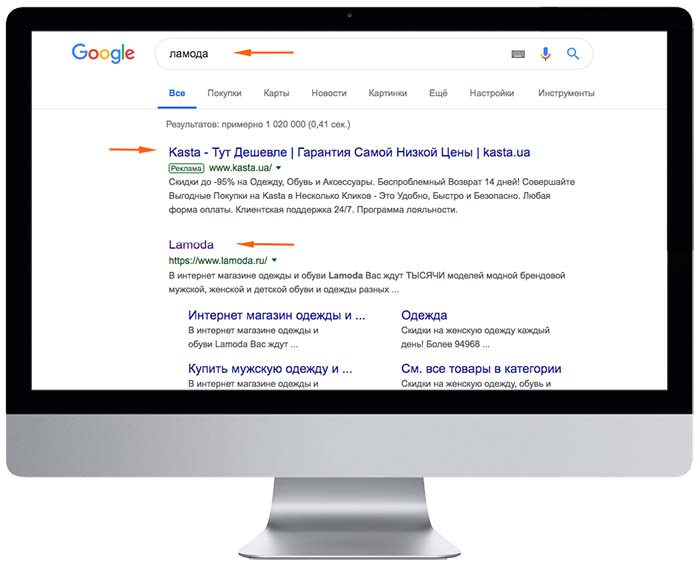Contextual advertising for competitors’ brands
To successfully get some traffic of competing companies, you can use the names of their brands when setting up contextual advertising. This method was banned by Google until 2008, but now the ban has been lifted and only moral and ethical considerations can interfere with using contextual advertising on competitors, this will not entail legal and regulatory consequences.

Advantages of contextual advertising for competitors’ brands
By setting up contextual advertising for competitors’ brands, you can:
- At low cost to get a part of the target audience of a competitor company;
- Get additional purchases and conversions on the site (perhaps every business owner strives for this);
- Declare yourself as an alternative. If you make a fascinating offer to a client, he will probably choose you;
- Increase brand awareness among users, expand audience coverage.
How many calls and sales will I get by ordering contextual advertising from you?
I need to calculate the conversion of my website
Describe
the task
in the application
Calculate potential ad revenue
Google
contextual advertising calculator
Do you need contextual advertising on competitors?
Before adding competitors’ trademarks to the list of CS, it is worth weighing all the pros and cons of this event. To clearly assess the situation, you need to answer at least 3 questions:
Is this ad suitable for a particular business?
Campaigns targeting competitors’ brands are not suitable for every type of activity.
The most justified such advertising will be in areas where there are not numerous competing organizations, and goods or services do not have strong differences in quality and functionality.
As an example, consider the smartphone market. If we assume that the potential client is not a zealous fan of your direct competitor’s brand, but chooses a phone according to its characteristics (memory, processor, camera), then advertising on the competitor’s brand is a winning strategy, which mobile phone manufacturers actively use.

Ads on competitors will not work in topics where there are a lot of them (to such an extent that users do not even remember the names of sites) or, conversely, when the market is narrow and comparison with a competitor can work against you.
Therefore, before launching such an advertisement, be sure to study the market. This strategy should not become the main one, and be applied in the early stages of promotion.
Are competitors advertising for my brand?
Find out if competitors are using your brand for advertising campaigns. A simple query in popular search engines is quite suitable for this purpose.
To explore data for other regions and devices, use the Google Ads Preview tool. If it turns out that competitors are already using this tactic with might and main, your decision to respond in kind is fully justified.
If they do not give such advertising, the decision is yours, perhaps you do not have personal acquaintances with a competitor company and do not expect any serious reaction from them. Then you can try to set up ads for their brands.
Did I choose the right competitors?
Use for targeting those competitors with whom your target audience intersects. It is useless to advertise your products and services against the backdrop of larger well-known brands, market leaders, or if your product (service) is inferior in quality compared to a competitor’s offer.
An example is a local gym, which may be the best in its area of the city, but it is not able to compete with large network gyms (they have their own, often loyal audience). Such advertising will not be effective and will not bring profit to the business.
It’s another matter when, compared to a competitor, your product looks much more attractive or is the best in its narrow niche.
What to consider when setting up ads for competitors’ brands?

If you decide to set up contextual advertising by competitors, use the following tips:
- Foremost, analyze your competitors. Study the market and use only direct competitors with a similar target audience for targeting. For example, if you only sell a certain type of shower enclosure, it would be pointless to set up branded ads for a large plumbing store;
- Do not use the name of registered trademarks in the text and title of the ad. This is prohibited by Ukrainian law. The mildest consequence if you are caught in this act is the ban of the Google Ads account. Material claims from the copyright holder are also possible. Therefore, you can’t explicitly write about competitors in the ad text, but no one forbids using their brand from the list of keywords to display ads;
- Track results. Google Analytics allows you to evaluate user behavior on the site. Frequently among the audience of a competitor you can see a high bounce rate, low conversion. After analyzing all the main indicators, you will be able to determine in time that advertising is not effective and refuse it without spending the entire budget;
- Select competitor traffic into a separate group. Use UTM tags, make hotel campaigns for ads on competitors – then you can control the effectiveness of this ad;
- Write an article comparing brands – your own and your main competitors. You can send traffic to this article from advertising on competitors’ brands. TM names in the text will increase the quality of the landing page for AdWords. This will reduce your CPC and improve your ad’s Quality Score.

